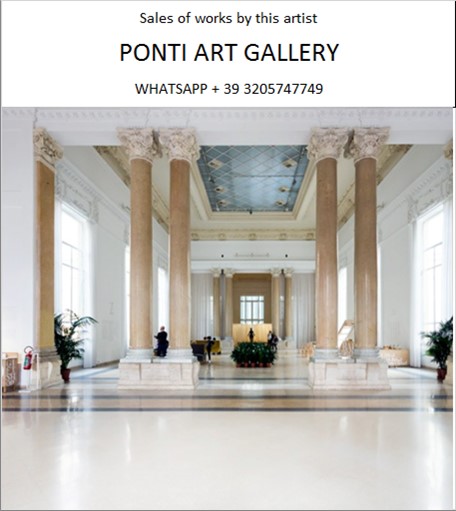Ponti Art Gallery is interested in buying and selling works
of art by this artist.

Sigmar Polke Biography
Sigmar Polke was a German artist, born on February 13, 1941, in Oels, Silesia, then part of Germany, now Oleśnica, Poland. His life and work were profoundly shaped by the historical and political upheavals of the 20th century, beginning with his family's flight from Silesia to Thuringia in 1945, during the expulsion of Germans after World War II. This early experience of displacement continued when Polke's family escaped from East Germany to West Germany in 1953, settling in Düsseldorf. This move from a communist regime to a capitalist society deeply influenced Polke's artistic outlook and would later inform his critical engagement with both political systems through his art.
Polke's artistic education began in earnest when he worked as an apprentice in a stained glass factory in Düsseldorf before enrolling at the Kunstakademie Düsseldorf (Düsseldorf Arts Academy) in 1961. There, he studied under influential teachers such as Karl Otto Götz, Gerhard Hoehme, and Joseph Beuys, who had a significant impact on his development as an artist. The 1960s were a time of great social, cultural, and artistic changes in Germany and elsewhere, and Düsseldorf, in particular, was a prosperous, commercial city and an important center of artistic activity. It was against this backdrop that Polke began to forge his path as an artist.
In 1963, Polke, along with fellow students Gerhard Richter and Konrad Lueg (later known as Konrad Fischer), founded the painting movement "Kapitalistischer Realismus" (Capitalist Realism). This movement was a critical response to both the Socialist Realism of the Soviet Union and the consumer culture of Western capitalism. Through Capitalist Realism, Polke and his contemporaries sought to critique the burgeoning consumer society of West Germany and the commodification of art. They employed a mix of irony, humor, and critical reflection, often using recognizable imagery derived from photography, advertising, and the mass media to challenge viewers' perceptions and invite a more critical social and economic analysis.
Polke's work from the 1960s, characterized by its engagement with Capitalist Realism, often mimicked and challenged American Pop Art. He used the half-tone dot process, reminiscent of newspaper photographic reproduction, to create paintings that blurred and obscured their subjects, thereby subverting the usual clarity expected from images, especially those depicting consumer goods or popular culture icons. This technique not only critiqued the superficial gloss of consumer culture but also questioned the nature of representation and the authenticity of the image.
Throughout the 1970s, Polke expanded his exploration of media and materials, working in photography, film, and video, and experimenting with a diverse range of substances, including toxic chemicals and natural elements, to produce spontaneous chemical reactions in his paintings. This period of experimentation reflected Polke's ongoing interest in challenging the boundaries of art and the processes of its creation. His travels to places like Paris, New York City, Afghanistan, and Pakistan during this time further enriched his work, introducing new themes and influences.
In the 1980s, Polke returned to painting with renewed vigor, producing works that were abstract yet deeply imbued with historical and political references. He continued to experiment with materials, combining traditional pigments with unconventional substances to create complex, layered works that defied easy interpretation. Polke's art from this period and beyond is characterized by its allusiveness and ambiguity, inviting viewers to engage in a dialogue with the work and draw their own conclusions.
Sigmar Polke's contributions to contemporary art are vast and varied. He was a prolific artist whose work spanned painting, photography, film, and beyond, always marked by a spirit of experimentation and a critical eye toward society and the art world. Polke passed away on June 10, 2010, in Cologne, Germany, leaving behind a legacy that continues to influence and inspire artists around the world. His work is included in major collections and has been the subject of numerous retrospectives, attesting to his enduring impact on the landscape of contemporary art.
Sigmar Polke Quotes and Sales
of Works
Ponti Art Gallery selects and deals with paintings by the
artist. Upon request, we provide free estimates and
evaluations, communicate prices, quotations, and current
market values.
If you are interested in BUYING or SELLING works by the
artist, contact us immediately.
If you wish to sell or receive an evaluation of the
works:
Send us a frontal photo of the painting, one of the back,
and one of the signature. Also, indicate the dimensions of
the work. Inform us about the purchase origin of the work
and any kind of available documentation (purchase
receipts, certificates of authenticity, publications). One
of our operators will respond to you on the same day. We
guarantee maximum confidentiality and extreme
professionalism.
If you wish to purchase works by the painter: Contact us
and let us know your request. We will inform you about the
available works. We also offer the possibility to
subscribe to our NEWSLETTER, through which you will be
informed at the beginning of each month about the latest
acquisitions of the art gallery.
You can send us pictures of the work:
